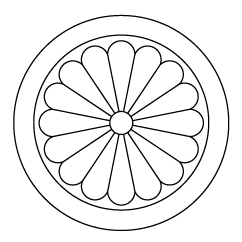|
||
 |
||

(C)2001 Japanese Architecture and Art Net Users System. No reproduction or republication without written permission.
掲載のテキスト・写真・イラストなど、全てのコンテンツの無断複製・転載を禁じます。
|
||||||
| kikkamon 菊花文 | ||||||
| KEY WORD : architecture / roofing tiles | ||||||
| A stylized chrysanthemum pattern derived from the
imperial crest used on the pendant *gatou 瓦当, of semi-circular convex tiles or as a band of small tiles called *irakagawara 甍瓦, that have the pendant, decorated with a chrysanthemum motif. The earliest
known kikkamon pendants date from the Momoyama period and were
unearthed at the site of Fushimijou 伏見城 in Kyoto. Another was unearthed in Kyoto.
Some fine examples were also found in Ootsu 大津 in Shiga prefecture. The number
found during the Edo period increased. A few in Kyoto in Higashiyama 東山
were excavated from Kiyomizudera 清水寺. This motif was used widely without restriction
during Edo period on the built up tiles above the ridges of various
buildings, but after 1868, its use was strictly controlled from the time of the
Meiji Restoration because the pattern was used for the crest of the Emperor. One
such example was unearthed at the site of the Sentou Gosho 仙洞御所 in Kyoto, and
dates from the Edo period. The rims on these tiles are broad and undecorated. |
||||||
 |
||||||
| REFERENCES: | ||||||
| *kikugawara 菊瓦 | ||||||
| EXTERNAL LINKS: | ||||||
| NOTES: | ||||||
(C)2001 Japanese Architecture and Art Net Users System. No reproduction or republication without written permission. 掲載のテキスト・写真・イラストなど、全てのコンテンツの無断複製・転載を禁じます。 |
||||||